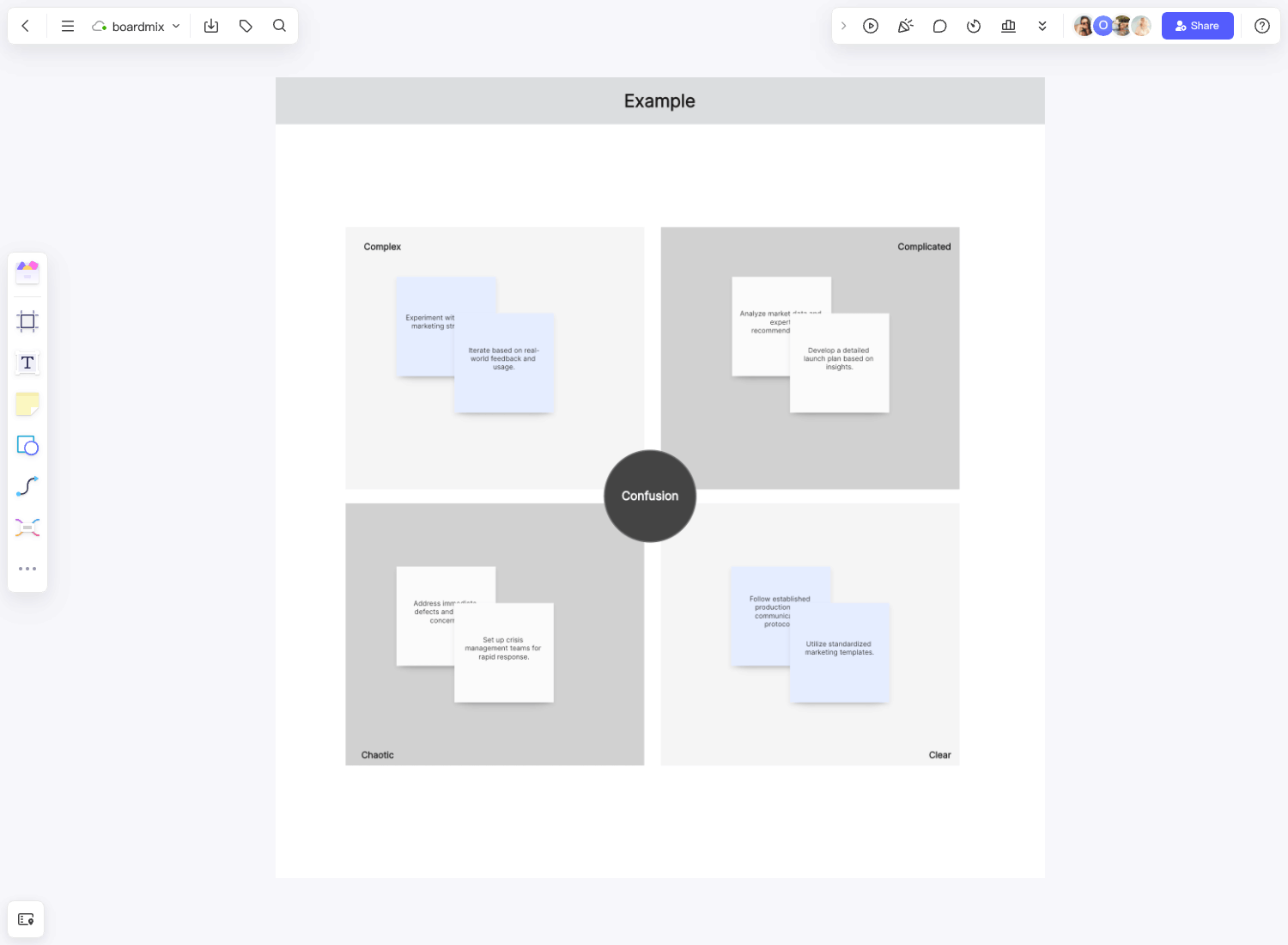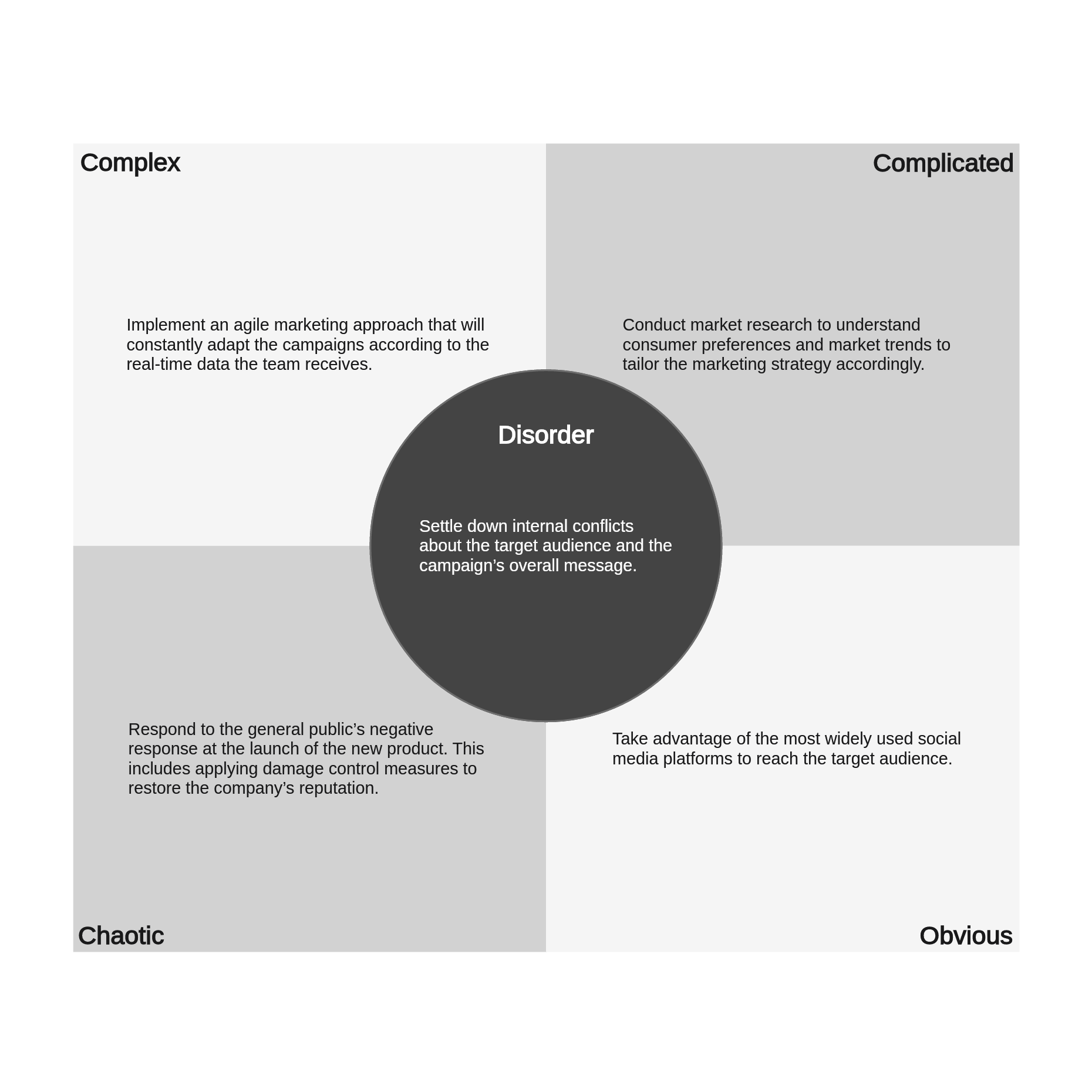Decision-making will always be an integral process in every business or organization. Various situations call for different approaches. This is why companies adopt structures and frameworks to ensure they are making the right judgments. One is the Cynefin framework, whose task is to help make sense of situations in front of you and make appropriate decisions associated with the specific scenario.
What is the Cynefin framework?
The Cynefin framework was developed and made known by Dave Snowden in 1999. Managers and executives across different industries use the framework to develop sound strategies. This structure has five domains that allow you to categorize various salutations so your team can provide specific approaches.
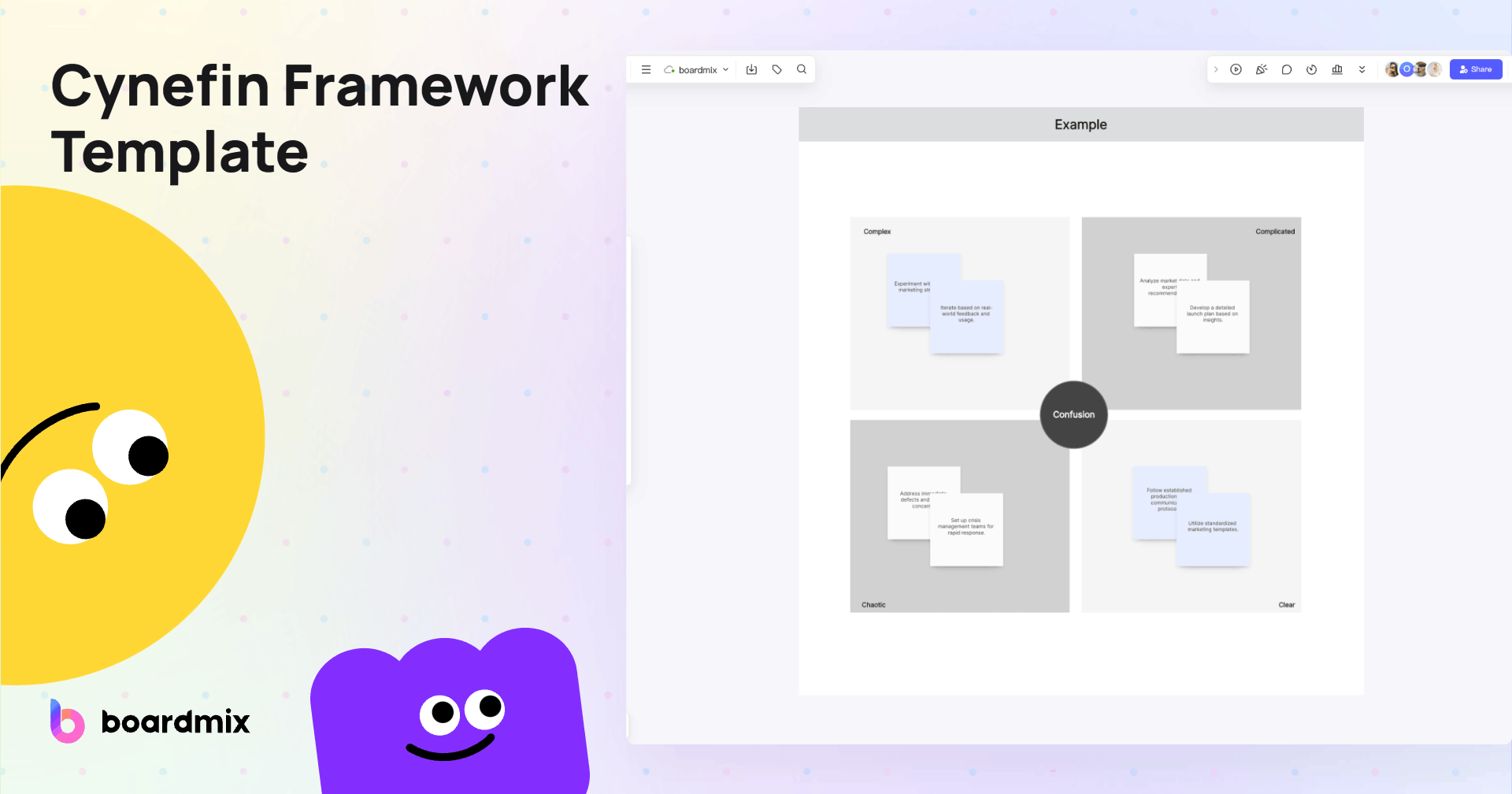
Build Cynefin Framework for Free
The framework's central idea is to provide decision-makers with a sense of place to assess their perceptions in dealing with problems and other situations. Not all scenarios are equal, and the Cynefin framework helps you define which response is needed for specific scenarios.
Benefits of using the Cynefin framework
Companies and organizations know several frameworks they use daily in decision-making and other business processes. They also utilize the Cynefin framework for the following benefits.
- It's a perfect training tool for almost any industry. The framework is ideal for developing critical thinking skills in leaders or honing the thought processes of existing ones. As a result, they will be more comfortable dealing with expected and unexpected hurdles.
- The Cynefin framework lets leaders think outside of the box. Along the way, using the framework helps them avoid the 'single-solution-fits-all-scenarios' mentality. Furthermore, it boosts fresh ideas and dynamic approaches.
- It allows better communication. The framework prevents confusion and miscommunication since leaders and team members have an aligned understanding of any situation.
- Using the Cynefin framework brings order to the organization. With an unexpected turn of events, some staff can't help but be shocked. Walking through the steps of the diagram helps in calming the surprised personnel.
- It takes note of previous behaviors of the company when dealing with challenges. The proven approaches from the past are being used for future decision-making while they can also look back to failed strategies in the past and improve them.
When should the Cynefin framework be used?
Businesses can use the model to categorize decisions or problems and identify appropriate responses. It aids in product development, organizational strategy, and marketing plans. Besides business, the framework is vital when responding to crises or unforeseen situations. New hires can also benefit from the template as they will be trained to react to various challenges.
For example, if you're dealing with a simple or clear problem where the cause-and-effect relationship is obvious, you would use the Cynefin framework to identify best practices and apply them. On the other hand, if you're faced with a complex problem where cause-and-effect relationships are only apparent in retrospect, this framework can guide you toward probing, sensing, and responding.
Remember that the Cynefin framework isn't a one-size-fits-all solution. It's a navigational tool that helps you categorize problems and choose the most effective strategies for dealing with them. So whether you're managing a team, navigating organizational changes, or trying to innovate within your industry, the Cynefin framework can provide valuable insights.
In addition to this practical application, it's also beneficial to use this framework for self-reflection and personal development. By understanding where your strengths and weaknesses lie within these different domains, you can better equip yourself to navigate various challenges in your professional and personal life.
In conclusion, the Cynefin framework should be used when you need to understand complex situations and make informed decisions. Its power lies in its ability to provide clarity amidst uncertainty and guide action towards effective solutions.
Cynefin Framework Examples
Cynefin Framework Example – 01
The first of the Cynefin framework examples that we are going to explain is in the context of product development. Here, you will see different situations for the different domains. This particular example is the following:

Build Cynefin Framework for Free
- Obvious Domain: Design a simple mobile app with a user-friendly UI and all the standard features.
- Complicated Domain: Design a complex system with a set of advanced features that require thorough planning and expertise from a skilled development team.
- Complex Domain: Create an innovative AI-powered online app, where there is a need for constant experimentation and feedback from beta testers from the early stages of development.
- Chaotic Domain: Deal with a sudden critical security flaw in the product that has exposed the users’ sensitive data.
- Disorder: Evaluate and handle conflicting user requirements, as well as internal disagreements in the development team, concerning the product’s features.
Cynefin Framework Example – 02
Taking our Cynefin framework examples into another area, we will examine how this framework will look in the hands of a marketing team. In this instance, all domains deal with situations that arise when the team is trying to market a new product. The example will look like this:
- Obvious Domain: Take advantage of the most widely used social media platforms to reach the target audience.
- Complicated Domain: Conduct market research to understand consumer preferences and market trends to tailor the marketing strategy accordingly.
- Complex Domain: Implement an agile marketing approach that will constantly adapt the campaigns according to the real-time data the team receives.
- Chaotic Domain: Respond to the general public’s negative response at the launch of the new product. This includes applying damage control measures to restore the company’s reputation.
- Disorder: Settle down internal conflicts about the target audience and the campaign’s overall message.
Cynefin Framework Example – 03
Some of the most interesting Cynefin framework examples you are going to encounter are the ones created by the managerial staff. In this instance, we are examining how a manager trying to handle internal conflicts with this tool:

Build Cynefin Framework for Free
- Obvious Domain: Resolve a minor scheduling conflict between team members by distributing tasks between them.
- Complicated Domain: Handle a disagreement about project priorities. This can happen by consulting previous successful project plans and asking the advice of other team leaders.
- Complex Domain: Handle a shift in organizational culture by experimenting with new communication and team-building strategies that will boost collaboration.
- Chaotic Domain: Deal with a sudden leadership crisis due to unexpected resignations, which includes the appointment of interim leaders.
- Disorder: Manage the conflicting perspectives that extend to a deeper, strategic level.
How to use the Cynefin Framework template?
The best way to create the Cynefin framework is through diagramming software like Boardmix. It provides templates you can edit, customize, and make your own. There's even better collaboration with creating the structure online as you can give the link to the template and share it with colleagues to access it from anywhere.
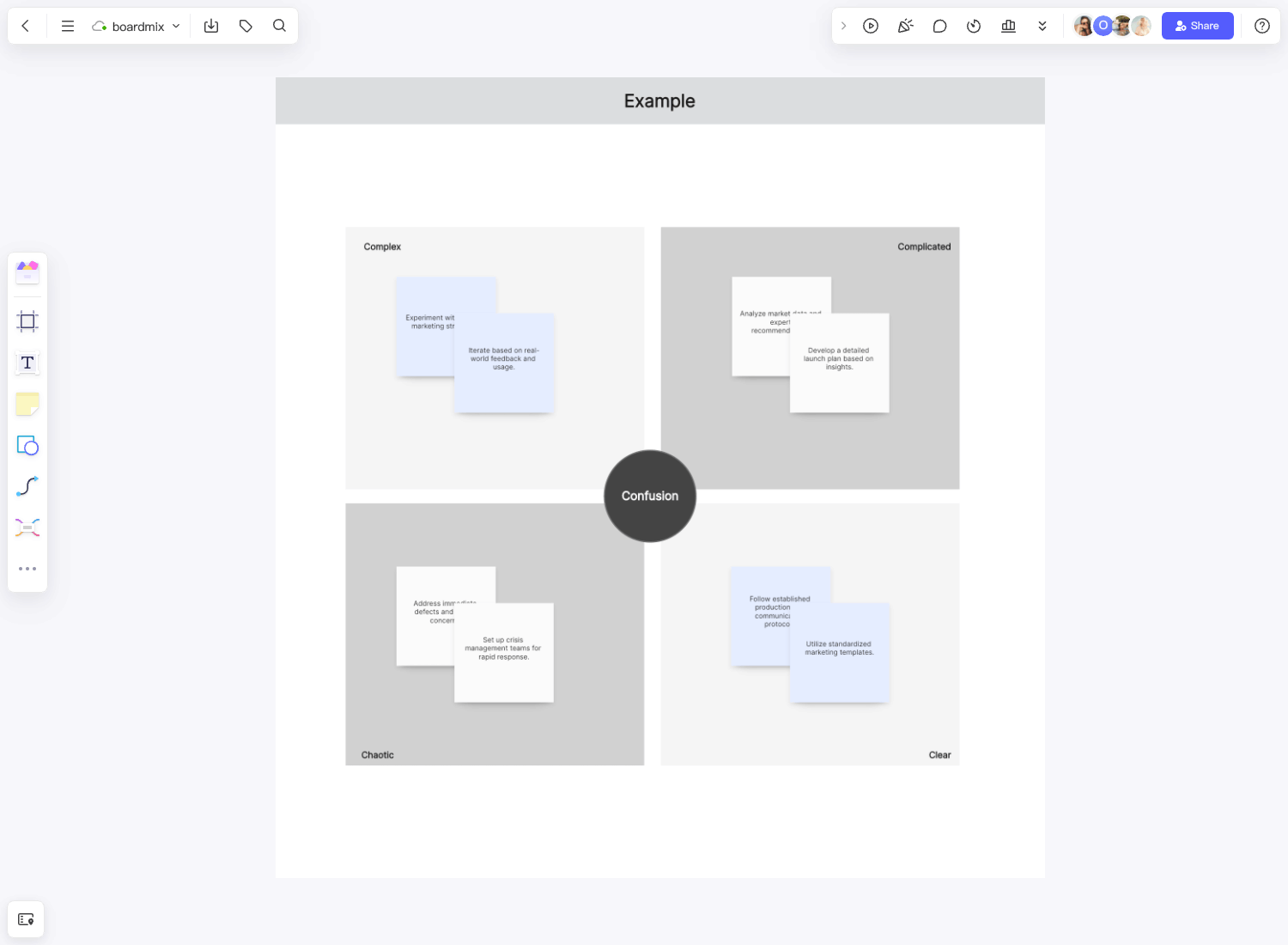
As you go through the diagram's steps, consider the following points below.
Step 1: Log in to Your Boardmix Account
To begin, you'll need to access your Boardmix account. Go to the Boardmix website and enter your login credentials. If you don't have an account yet, you can sign up for a new one for free.

Step 2: Search and Choose Activity Planning Template
Once you're logged in, head over to the Template library. You can find this in the main dashboard. Search for the Cynefin Framework Template and click to use it for free.

Step 3: Customize and Edit Your Own Cynefin Framework
Now that you've chosen the template, it's time to customize it according to your needs. You can use shapes, lines, drawing pens, icons, and other tools to decorate your template. The Cynefin Framework Template comes with several sections that you can fill out.
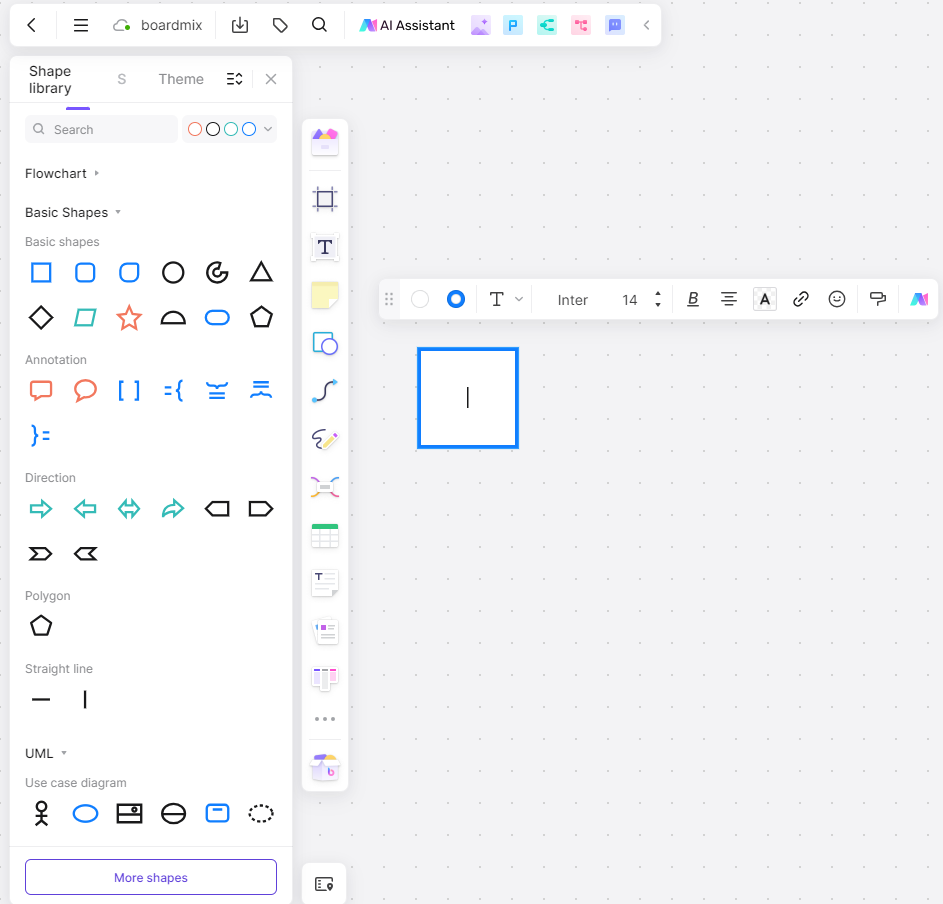
- Decide where the current challenges or situations stand. The solution is already known and might be easily applicable if it's an obvious challenge. Remember to use sticky notes as you segment the scenario on the right section of the template.
- If, after a series of discussions, your team discovers that the problem's status is complicated. This means the hurdle has unanswered questions. As you brainstorm possible approaches, apply the vital expert knowledge to determine the course of action.
- Sometimes, when the situation is complex, you must perform an experimentation analysis and assessment. The analysis aims to move this problem to the complicated category to pave the way to the right solutions.
- If you must place situations in the chaotic quadrant, you must control the problem first. Take quick action to contain the problem; identifying the best solution is your priority.
Step 4: Save Your Work, Share and Collaborate
When customizing your Cynefin Framework Template, Boardmix autosaves your progress, but it's good practice to manually save before exiting.
Next, share your activity plan to collaborate with your team. Click on the "Share" button on the top right corner of the screen, copy the sharing link, and send it to anyone whom you want to collaborate with. People can join this file to edit and collaborate on this file in real time by clicking this sharing link. We encourage your team to leave comments, suggest edits, or ask questions online so you can adjust it in time.
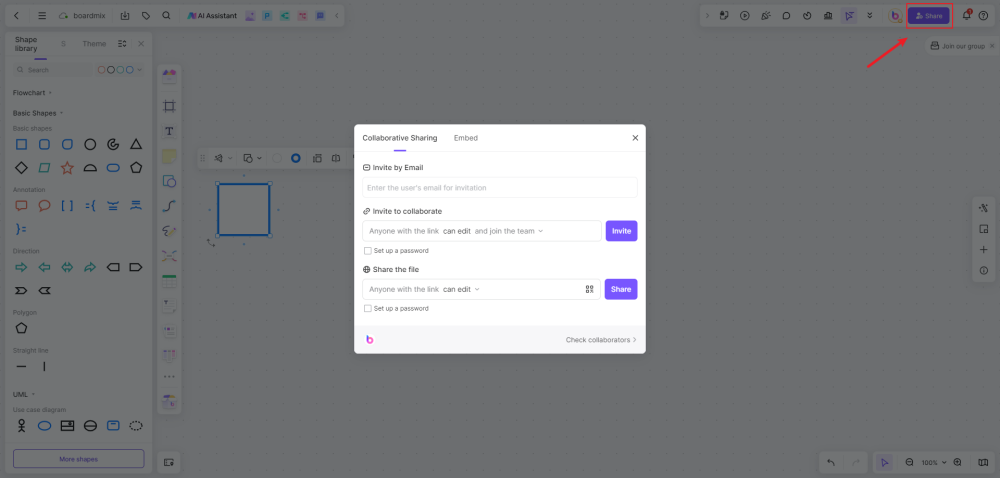
FAQs about the Cynefin framework
What are the five domains in the Cynefin framework?
The Cynefin framework outlines five domains, including the following:
- Obvious. This quadrant refers to situations the team has seen before and for which they have best practices.
- Complicated. Place the scenario if you have no idea what's happening but are equipped with the skills to analyze the situation and identify solutions.
- Complex. The situations written here are still being determined from the start. You can perform experimentation to understand the problem.
- Chaotic. These are unstable situations that need quick actions.
- Disorder. It refers to any scenario in which teams cannot identify the nature of the environment.
What are the criticisms of Cynefin?
Some organizations find the framework confusing and complicated. Others also say the structure needs a more solid foundation, and the possible contexts are limited. They see terms like categorize, sense, knowable, and known to be very vague.


